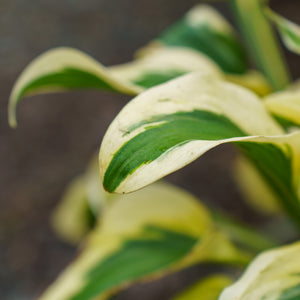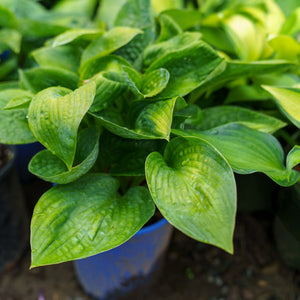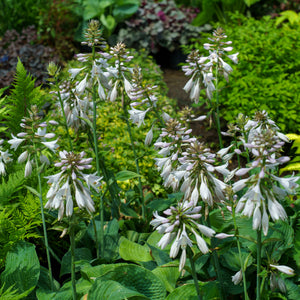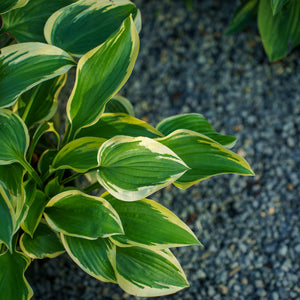The Hosta Guide
Hostas, renowned for their lush foliage and elegant form, are a staple in many garden landscapes. These hardy perennials are celebrated for their ability to thrive in shaded environments, bringing texture, color, and beauty to areas where other plants may struggle. Hostas are perfect for adding depth and interest to borders, beds, and woodland gardens. Their broad, heart-shaped leaves come in a wide array of colors, including deep greens, vibrant blues, and striking variegated patterns, making them a favorite among gardeners looking to create visually captivating designs. Whether you're seeking to create a tranquil shaded retreat or add bold foliage to your garden, Hostas offer a versatile and reliable solution. With minimal maintenance requirements and adaptability to different soil types, Hostas are a hassle-free addition to any garden. Explore our Hosta Guide to learn more about cultivating and caring for these beloved perennials, and discover how to incorporate them into your garden for lasting beauty and enjoyment.
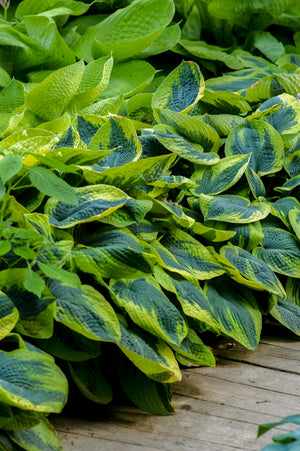
About
Hostas, often referred to as plantain lilies, are part of the Asparagaceae family and are cherished for their stunning foliage and adaptability to shady environments. Native to East Asia, particularly Japan, China, and Korea, Hostas have become a popular choice in gardens worldwide due to their resilience and ornamental appeal. These hardy perennials are known for their large, heart-shaped leaves, which come in a wide range of colors, including vibrant greens, soothing blues, and eye-catching variegated patterns of white, yellow, and cream.
Hostas produce elegant, lily-like flowers that bloom in the summer, typically in shades of white, lavender, or purple. These flowers rise on tall stems above the lush foliage and attract pollinators like bees and hummingbirds. While the blooms are a delightful addition, it is the foliage that makes Hostas a standout feature in garden design.
Thriving in partial to full shade, Hostas are ideal for shaded borders, woodland gardens, and container plantings. They prefer well-drained, humus-rich soil and benefit from consistent moisture, although they are relatively drought-tolerant once established. Hostas are also known for their longevity and ability to fill in garden spaces, providing a lush, ground-covering effect.
In addition to their aesthetic value, Hostas are low-maintenance and generally pest-resistant, although they can occasionally be troubled by slugs and snails. With proper care, Hostas can thrive for many years, becoming more beautiful and robust with each passing season.
Explore the diverse world of Hostas in our comprehensive guide, where you'll find insights into planting techniques, care practices, and creative ways to incorporate these versatile plants into your garden. Whether you're enhancing shaded corners, adding texture to borders, or designing striking container displays, Hostas offer endless possibilities for enriching your outdoor space.
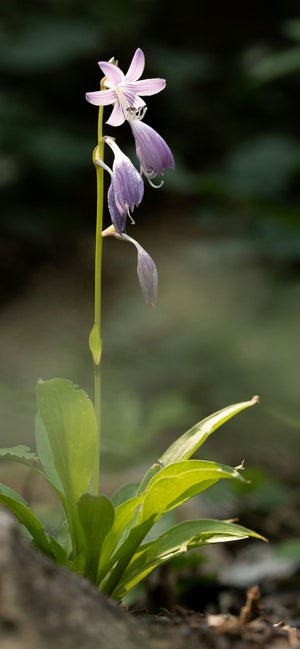
Planting
Hostas require specific planting conditions to ensure their successful establishment and flourishing growth. Here are some essential guidelines for planting and caring for Hostas:
Soil: Hostas thrive in well-drained, humus-rich soil with a pH level ranging from 6.0 to 7.5. Prepare the planting site by loosening the soil to a depth of about 12 inches and incorporating organic matter such as compost or well-rotted manure. This enhances soil structure, drainage, and fertility, providing a healthy environment for root development.
Sunlight: Hostas prefer partial to full shade, making them ideal for shaded garden areas. While some varieties can tolerate morning sun, they generally perform best in locations that receive dappled sunlight or are shaded during the hottest part of the day. Too much direct sunlight can cause the leaves to scorch, particularly in hotter climates.
Watering: Adequate watering is crucial, especially during the initial growth stages. After planting, water the Hostas deeply to ensure the roots receive sufficient moisture. Maintain consistent soil moisture, particularly during dry periods, but avoid waterlogging, which can lead to root rot.
Mulching: Apply a layer of organic mulch around the base of your Hosta plants to retain moisture, suppress weed growth, and regulate soil temperature. Use materials like wood chips, bark, or compost, ensuring the mulch is kept a few inches away from the plant stems to prevent moisture-related issues.
Spacing: Plant Hostas 1 to 3 feet apart, depending on the variety and their mature size. Proper spacing ensures adequate air circulation and reduces the risk of fungal diseases, promoting healthy plant development.
Planting Time: The best time to plant Hostas is in the spring or early fall when temperatures are moderate. This allows the plants to establish strong root systems before the onset of extreme weather conditions.
Depth: When planting Hostas, ensure the crown of the plant is at soil level or slightly above. Planting too deeply can hinder growth and flowering.
By following these planting and care instructions, you can ensure the successful establishment and thriving growth of your Hosta plants. With proper attention, Hostas will bring lush foliage and elegant beauty to your garden, enhancing its charm and appeal for years to come.
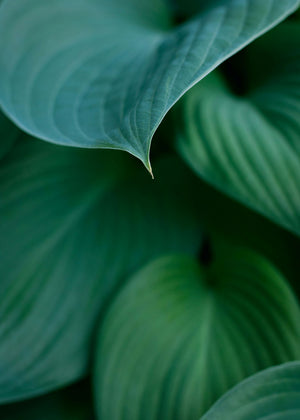
Care
Hostas require specific care to ensure their optimal growth and health. Here are some general guidelines for the care of Hostas:
Watering: During the growing season, provide regular watering to your Hosta plants. Aim to keep the soil consistently moist but not waterlogged. Water deeply at the base of the plant to encourage deep root growth and to prevent fungal diseases. Adjust watering frequency based on rainfall and weather conditions.
Pruning: Hostas generally require minimal pruning. Remove any dead or damaged leaves as needed to maintain a tidy appearance and to prevent disease. In the fall, cut back the foliage to the ground after the first frost to prepare the plants for winter. This also helps to reduce the presence of pests and diseases.
Fertilizing: Fertilizing can help boost the growth and vibrant foliage of Hosta plants. Apply a balanced, slow-release fertilizer in early spring when new growth begins and again in mid-summer, following the recommended dosage on the product label. Avoid over-fertilizing, as this can lead to excessive foliage growth at the expense of overall plant health.
Soil and Sunlight: Ensure that Hostas are planted in well-drained, humus-rich soil with a pH level ranging from 6.0 to 7.5. Hostas thrive in partial to full shade, making them ideal for woodland gardens, shaded borders, and areas with dappled sunlight. Some varieties can tolerate more sun, especially in cooler climates, but provide afternoon shade to prevent leaf scorching in hotter regions.
Mulching: Apply a layer of organic mulch around the base of your Hostas to retain moisture, suppress weed growth, and regulate soil temperature. Use materials like wood chips, bark, or compost, ensuring the mulch does not touch the plant stems directly to prevent rot and fungal issues.
Pests and Diseases: Hostas can be susceptible to slugs, snails, and deer, which can damage their foliage. Use organic or chemical slug repellents, and consider using deer repellents or protective barriers. Inspect your plants regularly for signs of pests and treat any infestations promptly. Hostas are generally resistant to most diseases, but proper spacing and air circulation help prevent fungal issues.
Dividing: Hostas benefit from occasional division to maintain vigor and prevent overcrowding. Divide the plants every 3-5 years in early spring or late summer. Dig up the clump, separate it into smaller sections, and replant them at the same depth as the original plant.
Winter Care: In colder climates, protect your Hostas from harsh winter conditions by applying a layer of mulch to insulate the roots. Remove any debris from around the plants in the fall to reduce the risk of pests and diseases overwintering in the garden.
By following these care guidelines, your Hosta plants will thrive and add lush foliage and elegant beauty to your garden for years to come. With their resilience, low maintenance requirements, and stunning leaves, Hostas are a valuable addition to any landscape, providing year-round interest and charm.
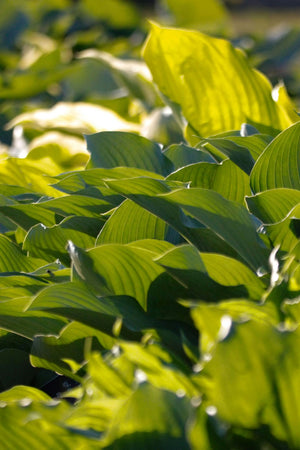
How To Use
Hostas offer versatility and can be utilized in various ways to enhance your landscape. Here are some recommendations based on their characteristics:
Shade Gardens: Hostas thrive in shaded areas, making them perfect for creating lush shade gardens. Plant them under trees or in areas with dappled sunlight to add texture and color to otherwise dim spaces.
Borders and Edging: Use Hostas to create elegant borders along pathways, garden beds, or driveways. Their broad, attractive leaves create a defined edge and add a sense of order and structure to your garden.
Mixed Perennial Beds: Incorporate Hostas into mixed perennial beds for continuous seasonal interest. Pair them with other shade-loving plants like ferns, astilbes, and bleeding hearts to create a diverse and visually appealing garden composition.
Containers: Hostas are well-suited for container gardening. Plant them in pots or mixed containers to enjoy their lush foliage up close. They are perfect for patios, balconies, and entryways, providing year-round interest and color.
Ground Cover: Use Hostas as ground cover to fill in bare spots in shaded areas of your garden. Their dense foliage helps suppress weeds and retain soil moisture, creating a lush green carpet.
Accent Plants: Plant Hostas as accent plants in your garden to highlight specific areas or features. Their striking foliage can draw attention to focal points or provide contrast to other plants.
Woodland Gardens: Hostas are ideal for woodland gardens, where they can blend seamlessly with other native plants. Their foliage adds texture and depth to naturalistic landscapes, creating a serene and tranquil environment.
Foundation Plantings: Use Hostas in foundation plantings around the base of your home or other structures. Their lush leaves soften hard lines and add visual interest to the landscape.
Seasonal Displays: Hostas can be used in seasonal displays to create stunning visual effects. Combine them with spring bulbs, summer annuals, and fall foliage plants for dynamic and changing garden displays throughout the year.
Pollinator Gardens: While primarily grown for their foliage, Hostas’ summer flowers attract pollinators like bees and butterflies. Plant them alongside other pollinator-friendly plants to support local wildlife.
When incorporating Hostas into your landscape, consider their growth habits, sunlight requirements, and soil preferences. By choosing the right placement and utilizing their versatile nature, Hosta plants can enhance the beauty and functionality of your outdoor space, providing year-round interest and vibrant foliage.
Conclusion
Hostas are a versatile and captivating addition to any garden landscape. With their lush, broad foliage and elegant form, these hardy perennials bring texture, color, and beauty to shaded areas where other plants may struggle. Their ease of care and adaptability make them a favorite among gardeners of all levels. By adhering to proper planting and maintenance techniques, you can fully harness the potential of Hostas to elevate your garden and make a lasting impact.
Whether you seek to create lush shade gardens, define borders, or design stunning container displays, Hostas can fulfill a variety of roles in your landscape design. Plant them individually to highlight their unique leaf patterns and colors, or cluster them together for a dramatic visual display. Hostas' adaptability also makes them ideal for ground covers, woodland gardens, and mixed perennial beds.
Beyond their ornamental value, Hostas contribute to the biodiversity of your garden ecosystem by attracting pollinators during their blooming season. Their low maintenance requirements and year-round interest make them an excellent choice for sustainable gardening. With their enduring beauty, versatility, and ecological significance, Hostas bring delight and natural allure to your outdoor environment, enriching your gardening experience and enhancing the overall beauty of your landscape.






